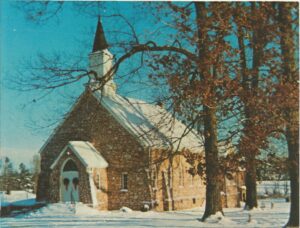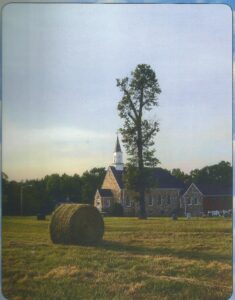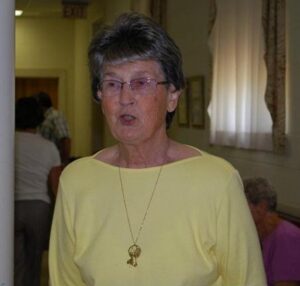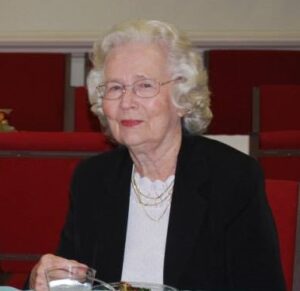Allensville Church History

The Allensville United Methodist Church, which began as Bethlehem Church in 1834 on the farm of Isaac Webb, was moved to its present site, six miles east of Roxboro, between 1855 and 1858. Two and two tenths acres of land were given by Ambrose H. Tingen and Robert C. Burch. Jas Burch acted as attorney for his father, Robert. W.N. Allen, one of the trustees, constructed the first church on the site and was the first person buried on the church grounds.
The daughter of Isaac Webb, Frances Moore Webb, published “The Weekly Message”, the first Methodist newspaper to be published in North Carolina. Miss Webb married Sydney B. Bumpass who helped her in this work and she continued the paper after his death.
The following pastors served Bethlehem and Allensville Methodist Churches, a part of the Person Circuit: 1834 R.O. Burton; 1835-1836 H.T. Weatherby; 1837 William Class; 1838-1839 Joseph Goodman; 1840 David B. Nicholson; 1841 W.M. Crumpton; 1842 Thomas S. Campbell; 1843-1844 John Tillett; 1844-1853 (No Record); 1854 William M. Jordan; 1855-1857 (No Record) 1858-1860 Theophelus Moore; 1860-1861 Paul J. Carroway; 1862-1863 John Tillett; J.P.Moore, Junior Pastor (Mr. Moore became one of North Carolina’s greatest preachers); 1864-1865 J.P. Carroway; 1866-1868 P.J. Carroway; 1869-1871 M.C. Thomas; 1872-1874 W.M. Jordan; 1875-1878 H.H. Gibbons; 1879-1881 (No Record); 1882-1883 J.S. Anford; 1884-1885 J.R. Griffith; 1886-1887 M.H. Hayle.
In 1887 the Person Circuit was divided and the Mt. Tirzah and Roxboro Charges were formed. Allensville Church was placed on the Mt. Tirzah Charge. Pastors on this charge were: 1887-1890 J.E. Underwood; 1893-1894 N.E. Coltrane; 1895-1896 W.B. Moore; 1897-1899 R.H. Broome; 1900-1903 M.D. Giles; 1904 W.H. Kirton; 1904-1908 J.B Thompson; 1909-1910 N.C. Yearby; 1911-1912 B.C. Allred; 1913-1916 J.J. Boone.
In 1917 the Mt. Tirzah Charge divided making the Mt. Tirzah and Brooksdale Charges. The Brooksdale contained five churches: Allensville, Brooksdale, Brookland, Trinity, and Webbs Chapel. Pastors serving these five churches were: 1917-1920 J.A. Russell; 1921 J.C. Whedbee; 1921-1924 B.T. Hurley; 1925-1926 W.L. Loy; 1927-1932 S.F. Nicks; 1933-1935 R.E. Pittman; 1935-1939 T.W. Lee; 1940-1942 D.A. Petty; 1942-1950 E.C. Maness; 1950-1954 D.D. Traynham.
In 1955 the Brooksdale Charge was divided into the Brooksdale-Brookland Charge and the Allensville-Trinity-Webbs Chapel Charge. Pastors of this charge were: 1954-1955 Tommy Clayton; 1955-1959 H. Arthur Phillips; 1959-1963 G. Waylon Cooke; 1963-1968 Eric O. Murray; 1968-1972 Russell R. Knowles; 1972-1976 Jack Ruth; 1976-1978 William P. McComas; 1978 Bobby L. Privette.
The parsonage for this charge was completed March 20, 1956, and was occupied by Rev. Arthur and Peggy Phillips. The first child born to a pastor of this charge was their son, Jonathan David Phillips, born November 4, 1957, at the Person County Memorial Hospital. The parsonage was dedicated November 17, 1957, by Dr. C.D. Barclift, District Superintendent.
Webbs Chapel disbanded around 1972. The property was sold by the conference in 1978 and its membership was added to the roll at Allensville Church. The church building still stands as of 2024 and is located at 401 Vernon Hill Church Rd in Person County.
In 1931 the old church building, built around 1855, was almost falling down. This was during the depression and none of the members had money to build a new church. The story goes that Howard Haines, an architect, was standing on the church yard with some of the members, discussing the problem and kicking around stones. While talking, he asked if there was much of the rock around. He was told farmers had been picking flint rock out of their fields since slavery days. There were piles of it all over the countryside. Thus, came the idea to build the present building of native flint rock.
Working Bees
An ecumenical movement began in the Allensville Community, led by Rev. Samuel Nicks, Pastor of the Church. Baptist, Methodist, men, women, children, black, white, worked together hauling rock, cutting and sawing timber to build the church. They organized “Working Bees” with as many as forty men, 17 teams of mules plus women and children. The women served Brunswick Stew for dinner and supper to the workers. Some of the men went out the night before and killed squirrels for the stew.
Jim Painter, the rock mason, was the highest paid man on the job. He received twenty five cents an hour and room and board with Thelma and Robert A. Gentry, valued at fifty cents per day. Laborers were paid seven and one half to ten cents per hour. Those with the teams were paid a little more.
Plans for the building were drawn in 1931, and the building was completed in July 1933. It was said that Mr. Painter, who had a taste for blackberry wine began tasting before noon on the last day of the stone laying and was unable to lay the last five stones. Mr. Eddie Gentry, the senior trustee of the church climbed the scaffold and laid the last stones.
The Duke Endowment supplied much of the cash for the building. The women sold Skidoo (a commercial preparation made with pumice, used for cleaning grease or tobacco gum from the hands), ties, brooms, stew, suppers, ice crea, flavoring and quilts to raise money.
Mrs. Robert Gentry was quoted saying, “I never knew anything like it, before or since. Building our Church brought a whole new spirit to this community, thanks to God and Mr. Haines.”
The old church was purchased by Robert A. Gentry, who tore it down and used the lumber to build a pack barn for tobacco. You can still find the double doors and wide, hand-hewn boards on the farm owned by his two sons Robert William and Alfred Gentry.

Educational Building
Around 1960, members felt the need for an educational building to provide more space for Sunday School classes and a fellowship hall with kitchen facilities. Mr. Howard N. Haines, who was architect in 1931 drew the plans for the educational building in 1964. He chose to use pink brick to blend with the pink in the flint rock. He designed the addition so it would not be seen when directly in front of the Church to maintain the appearance of the original structure.
The building committee consisted of Charles A. Gentry, Mrs. Alfred Gentry, John Walker, and Thomas O. Gentry. Rev. Eric O. Murray was instrumental in the planning and securing the loan and help from Duke Endowment.
The first money for the building was given by Mrs. Eddie Gentry, a fifty dollar donation, on December 23, 1960. Brunswick Stew was sold to all three shifts at Collins and Aikman’s Plant, Roxboro, to help raise funds. Donations were given by businesses and individuals. The first Harvest Sale was held November 11, 1964, and continues to be an annual event. The building was contracted to Wilkerson’s on July 25, 1966 for $57,963.47. Grants in the amount of $11,600 were given by Duke Endowment and a loan was secured from the Mission Board Inc. of the North Carolina Annual Conference. This loan was repaid two years early.
True to tradition, everyone worked together to make a dream a reality. The Educational building was dedicated by Bishop Robert M. Blackburn, “In the name of the Father, and of the Son, and of the Holy Spirit to its proper and sacred uses”, March 9, 1975.
Bishop Robert M. Blackburn, Raleigh Area Bishop; Rev. H. Langill Watson, Durham District Superintendent; Rev. Jack Ruth, Minister; and former ministers Rev. H. Arthur Phillips, Rev. Eric O. Murray, and Rev. Russell R. Knowles participated in “The Service of Worship and Dedication”.

by Stella Gentry

Our church historian is Grace Crow, who has collected and catalogued decades of information about our church. She would be more than happy to share some of her information with you.

